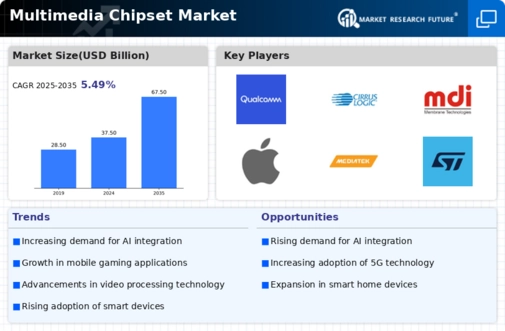Market Share
Multimedia Chipset Market Share Analysis
The Multimedia Chipset Market, a critical component of the electronics industry, employs various strategic approaches to secure and enhance market share. In this competitive landscape, companies within the sector employ diverse strategies to stay ahead. Differentiation stands out as a fundamental strategy, wherein manufacturers seek to distinguish their multimedia chipsets from competitors by incorporating unique features. Whether it's advanced graphics processing capabilities, energy-efficient designs, or compatibility with emerging multimedia standards, differentiation is key to attracting customers and establishing a distinct market presence.
Pricing strategies play a crucial role in the multimedia chipset market, where companies must balance affordability with performance. Some manufacturers adopt a cost leadership strategy, focusing on efficient production processes and economies of scale to offer competitive prices. This approach targets a broad consumer base looking for budget-friendly solutions. Conversely, premium pricing strategies are embraced by companies emphasizing high-end features, cutting-edge technologies, and top-notch performance. This appeals to consumers who prioritize quality and are willing to invest in premium multimedia experiences.
Strategic collaborations and partnerships are common in the multimedia chipset industry. Companies often join forces with original equipment manufacturers (OEMs), software developers, or other players in the ecosystem. These collaborations can lead to mutually beneficial agreements, ensuring a consistent demand for multimedia chipsets and fostering a strategic position in the market. Additionally, partnerships may result in joint ventures for research and development, accelerating innovation and keeping products aligned with industry trends.
Market segmentation is another key strategy, where companies tailor their multimedia chipsets to specific consumer segments. Recognizing the diverse needs of users, manufacturers create specialized chipsets for gaming, home entertainment, mobile devices, and automotive applications. This targeted approach allows companies to capture a larger market share within each niche, catering to the unique requirements of different customer segments.
Innovation is a driving force in the multimedia chipset market. Continuous research and development efforts are crucial for staying ahead of technological advancements. Companies invest in new technologies such as artificial intelligence for image and video processing, enhanced graphics capabilities, and efficient power management. Innovations in multimedia chipsets not only attract early adopters but also position manufacturers as industry leaders, contributing to market share growth.
Marketing and brand positioning are essential elements in the highly competitive multimedia chipset landscape. Effective marketing strategies, such as creating compelling brand narratives, leveraging social media, and participating in industry events, help build brand recognition and trust. A strong brand presence can influence consumer choices and contribute to a larger market share.
Customer support and post-purchase services also play a significant role in market share positioning. Responsive customer support, warranty programs, and regular software updates contribute to customer satisfaction and loyalty. Satisfied customers are more likely to become brand advocates, recommending products and influencing others in the purchasing decision, ultimately contributing to market share growth.
The expected increase in spending money, along with the widespread adoption of technological advancements in developing economies, is likely to contribute to market growth.
For instance, in December 2018, Qualcomm Technologies announced a modem specifically designed for Internet of Things (IoT) applications, such as asset trackers, health monitors, security systems, smart city sensors, and wearable trackers for intelligent meters. This modem is cost-effective and consumes 70% less battery compared to its predecessor.
However, the higher initial costs associated with setting up manufacturing units are limiting the development of the multimedia chipsets market.









Leave a Comment